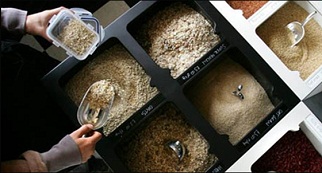As consumers increasingly look for economical ways to live, and gravitate towards unique retail experiences, "bring your own packaging" (BYOP) has gone from kooky concept to a credible retail business model. For many brands, the idea of BYOP is a hugely disruptive one - with a perception of creating less brand awareness, and involving considerable supply change disturbance.

But with retailers increasingly looking to streamline costs and reduce packaging, and with consumers seeing sustainability as a core value of any brand, will BYOP move into the mainstream? Will this result in opportunities for disruptive innovation, or be a brand equity disaster?
The whole idea of BYOP can be traced back to food markets, where consumers would bring their own bags and, tubs and jars to take produce home. As packaging became a battleground for sustainability, this method of "pre-cycle" appealed to consumers looking for efficiency. With supermarkets now introducing ‘bring your own bag' schemes and charging for carrier bag usage, retail packaging has been put in an uncomfortable focus. Alongside this, consumers have been increasingly vocal about packaging on the branded products they buy.
More than 86 percent of U.S. and U.K.consumers believe that food manufacturers need to cut down on the amount of packaging they use-something that many companies have taken note of. In the last couple of years a variety of different brands have looked to reduce their packaging and even pivot their business model around the initiative. Kenco shook up the coffee category with its eco-pouches, and Method has a considerable amount of its business model based on refillable packaging. But despite these innovations, the packaging landscape has relied on light-weighting and material reduction to meet the sustainability demands of both consumers and retailers.
However, 40 percent of U.K. and U.S. consumers make a food purchasing decision based on how much packaging is used - interestingly this increases to 48 percent among the 21-34 year old age range, showing that younger consumers will put additional pressure on brands to reduce or even eliminate their packaging. And it is these younger consumers who are driving the BYOP concept, through a desire to be sustainable but also to return to more efficient, raw methods of retail. This generation is increasingly rejecting clinical, corporate design in favor of something unpolished and experiential - something reflected in not only what products they buy and use, but also where they buy them.
In.gredients is packaging free
In.gredients is an example of this new expression of retail; based in Austin, TX, it sells locally or locally sourced food in packaging-free formats, requiring consumers to come in with their own containers, tubs, bags and jars. The UK has its own version in Unpackaged, a boutique grocery store that sells bulk products without packaging. Both stores are at the higher end of the market, showing that more affluent consumers are likely to buy into the concept.
This is further backed up by The Soap Dispensary in Vancouver, which is "a refill store specialising in premium household soaps, cleaners and personal care products." By eliminating packaging, these retail stores have to rely more on the quality, uniqueness and freshness of their produce to maintain a loyal consumer base - resulting in a more premium product offering.
Elements of these retail formats have filtered through to the mainstream with olive oil dispensers and beer kegs, but seems restricted to a niche audience. The main barrier will be convenience, as well as the fact that some categories are better suited than others - such as coffee, oils, milk, soaps and other commodities.
So what are the opportunities for brands in BYOP? Is this a fad that will slowly die out, or something that will grow in popularity?
It's unlikely that this business model will extend beyond being a high end, niche format and that our mainstream retail stores will soon become a sea of bulk containers. However, brands should note the strength of consumer demand for sustainable packaging and revolutionary pack formats. Simply changing a material or reducing packaging weight by a percentage is not enough - consumers need tangible evidence they can see and feel.





